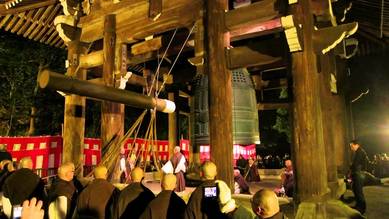Matsuri
|
Written for the James Madison University Brass Band
Scored for Brass Band Completed in 2107 Duration: 17 minutes Premiered on January 18, 2017 Royal Northern College of Music Brass Band Festival Manchester, United Kingdon James Madison University Brass Band Kevin Stees, director |
|
Performance by James Madison University Brass Band
Program Note

Matsuri (Festivals) is a musical celebration inspired by scenes from three traditional Japanese festivals. The first movement, “Fireworks at Ryogoku Bridge,” is inspired by the many Edo-period paintings of autumn evening fireworks festivals over the Sumida River in Tokyo. The movement flows with a sense of unbridled energy, joy, and enthusiasm as sparks flare and bright flashes of light sparkle against the night sky.
The second movement, “Bells on New Year’s Eve,” is inspired by the ceremonial ringing of temple bells at midnight on New Year’s Eve, known as Joya no Kane (除夜の鐘). In this ceremony, the temple bell is rung 108 times with the final ring of the bell just after midnight. Each tolling of the bell represents one of the 108 worldly desires of Buddhist teachings, and the ceremony signifies the cleansing of these desires to begin the year spiritually renewed. While not a literal musical narration of this event, this movement of Matsuri features two contrasting prayer-like laments that make up the thematic tapestry of the movement: one hopeful and optimistic “prayer of reconciliation,” and a second sorrowful “prayer of anguish.” Several passages showcase lyrical and expressive solos, and a gesture representing the tolling of bells does in fact occur exactly 108 times in various forms over the course of the movement.
The final movement, “The Burning of Mount Wakakusa,” is inspired by the annual festival Wakakusa Yamayaki (literally “Wakakusa Mountain Roast”) during which the grass hillside of Nara’s Mount Wakakusa is set on fire. The tradition supposedly originated from a boundary dispute between two neighboring temples in 1760 that resulted in the entire mountain being set aflame after mediations over the territory failed. Today, the festival begins with the ceremonial igniting of the mountainside by members of both temples followed by an elaborate fireworks display over the burning foliage. This movement reawakes the fiery excitement of the first movement’s pyrotechnics, pitting huge shouts and explosions of color against a current of danger and the threat of the festivities growing out of control.
The second movement, “Bells on New Year’s Eve,” is inspired by the ceremonial ringing of temple bells at midnight on New Year’s Eve, known as Joya no Kane (除夜の鐘). In this ceremony, the temple bell is rung 108 times with the final ring of the bell just after midnight. Each tolling of the bell represents one of the 108 worldly desires of Buddhist teachings, and the ceremony signifies the cleansing of these desires to begin the year spiritually renewed. While not a literal musical narration of this event, this movement of Matsuri features two contrasting prayer-like laments that make up the thematic tapestry of the movement: one hopeful and optimistic “prayer of reconciliation,” and a second sorrowful “prayer of anguish.” Several passages showcase lyrical and expressive solos, and a gesture representing the tolling of bells does in fact occur exactly 108 times in various forms over the course of the movement.
The final movement, “The Burning of Mount Wakakusa,” is inspired by the annual festival Wakakusa Yamayaki (literally “Wakakusa Mountain Roast”) during which the grass hillside of Nara’s Mount Wakakusa is set on fire. The tradition supposedly originated from a boundary dispute between two neighboring temples in 1760 that resulted in the entire mountain being set aflame after mediations over the territory failed. Today, the festival begins with the ceremonial igniting of the mountainside by members of both temples followed by an elaborate fireworks display over the burning foliage. This movement reawakes the fiery excitement of the first movement’s pyrotechnics, pitting huge shouts and explosions of color against a current of danger and the threat of the festivities growing out of control.

